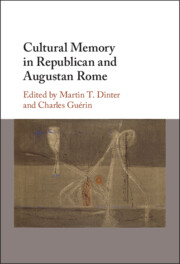Book contents
- Cultural Memory in Republican and Augustan Rome
- Cultural Memory in Republican and Augustan Rome
- Copyright page
- Contents
- Figures
- Contributors
- Acknowledgements
- Chapter 1 Introduction: What is Cultural Memory?
- Part I Writing Cultural Memory
- Part II Politicising Cultural Memory
- Part III Building Cultural Memory
- Part IV Locating Cultural Memory
- Chapter 19 Exchanging Memories: Coins, Conquest, and Resistance in Roman Iberia
- Chapter 20 Cicero and Clodius Together: The Porta Romana Inscriptions of Roman Ostia As Cultural Memory
- Chapter 21 Augustan Cultural Memories in Roman Athens
- Chapter 22 Different Pasts: Using and Constructing Memory in Augustan Carthage and Corinth
- Bibliography
- Index Locorum
- Index
Chapter 22 - Different Pasts: Using and Constructing Memory in Augustan Carthage and Corinth
from Part IV - Locating Cultural Memory
Published online by Cambridge University Press: 27 April 2023
- Cultural Memory in Republican and Augustan Rome
- Cultural Memory in Republican and Augustan Rome
- Copyright page
- Contents
- Figures
- Contributors
- Acknowledgements
- Chapter 1 Introduction: What is Cultural Memory?
- Part I Writing Cultural Memory
- Part II Politicising Cultural Memory
- Part III Building Cultural Memory
- Part IV Locating Cultural Memory
- Chapter 19 Exchanging Memories: Coins, Conquest, and Resistance in Roman Iberia
- Chapter 20 Cicero and Clodius Together: The Porta Romana Inscriptions of Roman Ostia As Cultural Memory
- Chapter 21 Augustan Cultural Memories in Roman Athens
- Chapter 22 Different Pasts: Using and Constructing Memory in Augustan Carthage and Corinth
- Bibliography
- Index Locorum
- Index
Summary
Since the work of Maurice Halbwachs, the spatial dimension and conditionality of memory – its connectedness and links to space and place – have been well known.1 Halbwachs asserts that collective memory is only possible if it is ‘localized’.2 Hence, the trope of a city or town as a landscape of memory has become fixed in memory studies and has even given rise to the term ‘urban memory’.3 Urban memory can refer to anthropomorphic phenomena (as when the city is said to have a memory of its own). More commonly, however, it points to the city’s status as a physical place and an ensemble of objects and practices which enables recollections of the past and embodies it through traces of successive building and rebuilding.4 The inhabitants of a city thus draw upon its image to identify with its past and present as a political, cultural, and social entity. In that sense, the urban landscape of Republican and Imperial Rome has thoroughly been investigated and reconstructed as a landscape of memory.
Keywords
- Type
- Chapter
- Information
- Cultural Memory in Republican and Augustan Rome , pp. 394 - 412Publisher: Cambridge University PressPrint publication year: 2023



